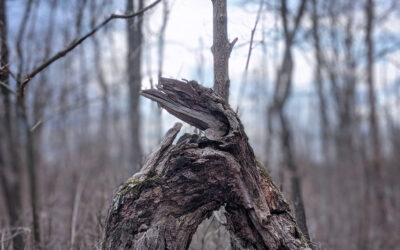Updating the Apple Cart
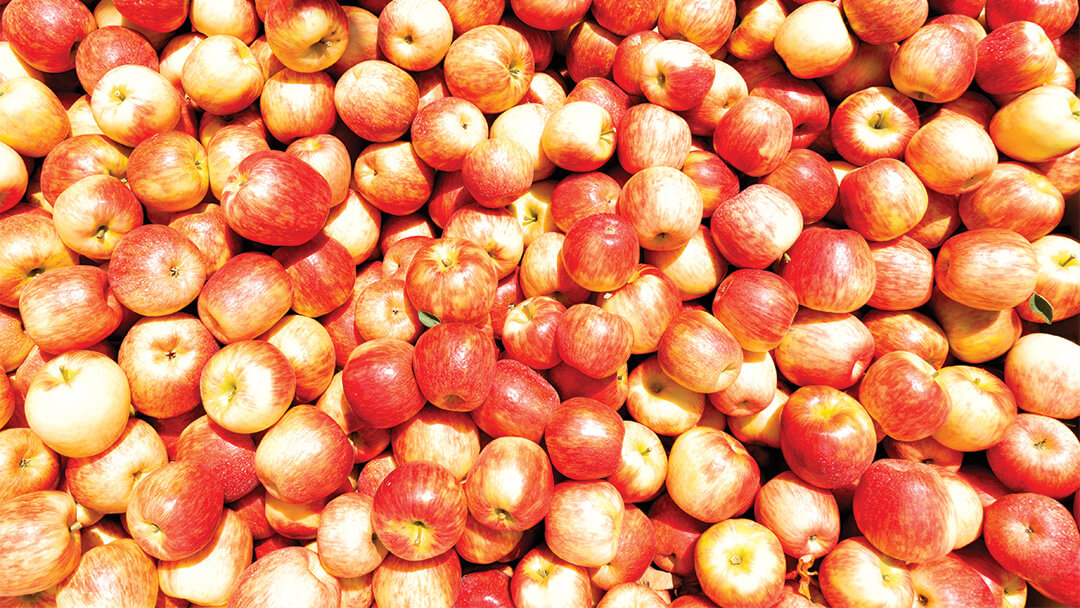
In Adams County, the largest producer of apples in the Commonwealth and the fourth largest producer of apples in the country, growers are adapting to a changing industry while trying to find the next megahit fruit.
Driving around Adams County looks and feels like much of the rest of rural Pennsylvania: corn fields, small towns perched along two-lane roads, backroads that curve and twist with the lay of the land. But then a rolling hill looms up and instead of cows grazing, there are trees. Neatly planted in rows, they are the bread and butter of this southern Pa. county — apples.
Lee Showalter, grower services manager at Rice Fruit Company, the largest apple packing facility east of the Mississippi, has been in the business most of his life. “This is my 50th crop,” he says. He’s taking us on a tour of some of the orchards surrounding the packing facility and storage warehouse.
From the backseat of his white F-150, someone points to a row of trees as we drive past and asks what variety it is. Showalter isn’t sure.
“It used to be when we were growing Reds and Golds and some of the older varieties, I could look at a big old tree and say that’s a so-and-so variety,” he says. “They have their own wood characteristics and what not. It’s not so easy anymore. You get the little stick in the ground and some leaves and if you don’t know what it was when you put it in the ground, you don’t know. Could be anything.”
He’s pointing out a shift in the industry that he’s watched over the decades he’s been a part of it (like many people in the fresh fruit industry in Adams County, he’s not the first generation in his family to work in this business).
In recent years, the trees have gotten smaller, making it easier to pick the fruit, and the varieties have multiplied, almost exponentially.
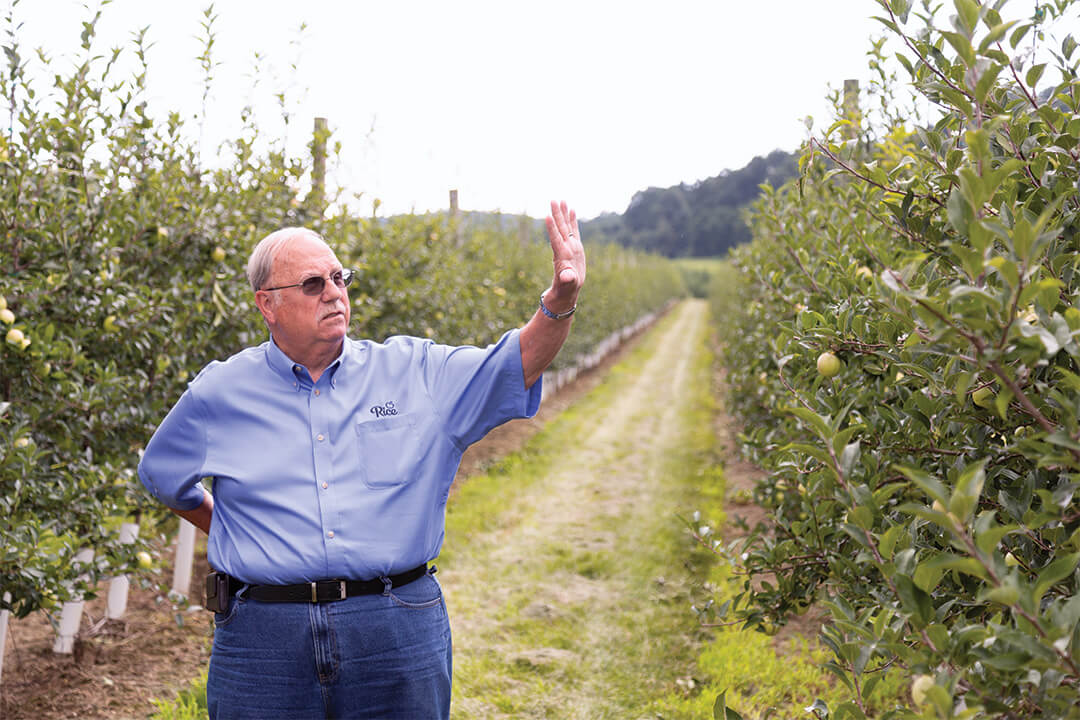
Lee Showalter points out the new style of trellised trees
“It started with Honeycrisp, and it has really changed everything,” says Ben Rice, president of Rice Fruit Company and part of the fourth generation of leadership there. “It’s hard to overestimate the amount of disruption that variety caused, most directly because of the amount of dollars it brought in and that it can capture.”
Before Honeycrisp, which was developed by a team of researchers at the University of Minnesota and released to the public in 1991, consumers had few choices at the grocery store. Red Delicious, Golden Delicious and McIntosh are among the top old-type varieties; Fuji and Gala were developed in the 1960s and ’70s and took hold of the market with steady growth. Last year, the U.S. Apple Association announced that for the first time in more than 50 years, Red Delicious was not the top U.S. grown apple; Gala took its place. Honeycrisp holds the fifth spot.
That shows how long it might take for a variety to assert dominance over the market, but Honeycrisp was the new kid on the block in a globalized marketplace — and consumers were willing to pay two to three times more.
“Suddenly people were making a lot of money,” says Rice. “Consumers were so excited. That got everybody’s attention.”
Honeycrisp is a great eating apple, but it’s kind of a pain for growers. “Everything that could go wrong does go wrong — and how,” says Rice, whose sister company R&L Orchards plants many varieties, including the popular Honeycrisp.
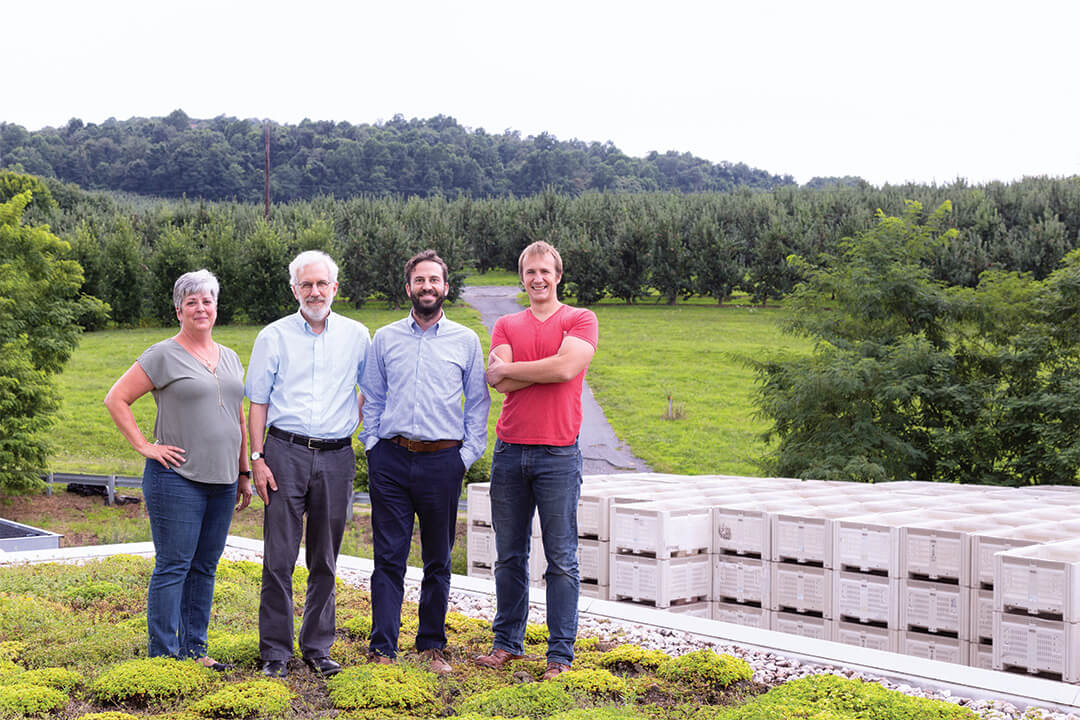
Brenda Briggs, Ted Rice, Ben Rice and Danijel Lolic on the green roof at Rice Fruit Company
But growers continue to dedicate acres to the popular variety because it’s what the market demands. It’s also what’s needed to recoup high upfront investment costs.
“As with the rest of agriculture, input costs have gone up a lot, and so growers have had to become a lot more efficient,” says Showalter. “The Pennsylvanian apple industry was once pretty heavily skewed toward apple processing (for products like apple juice and applesauce), and there’s been a change within the last 5 to 7 years in that a lot of the processing acreage is declining and growers are converting their acreage over to fresh apple varieties. The returns for fresh apples are more in line with what growers need to make a profit.”
A box of fresh Galas, for example, sells for about $30. Send that same box to the processor, and you’re getting $4.
It’s no wonder then that growers are looking for anything to edge out competition and make top dollar for fresh fruit. But sometimes, the next best thing comes to you.
“My grandfather, Steve, and my father, Dave, were driving around and saw that this one Honeycrisp tree was ripe,” says Blake Slaybaugh, vice president and fifth generation at Mt. Ridge Farms. “They’re saying, ‘It’s August 11 — why is this tree ripe?’ They marked the tree and came to it next year, and it was the exact same thing. The tree was 21 days early. Wow. We got something here.”
What they discovered came to be known as the Premier Honeycrisp, a trademarked variety that was released in 2014 and is licensed through Adams County Nursery, one of the largest suppliers of commercial and backyard fruit trees in the country.
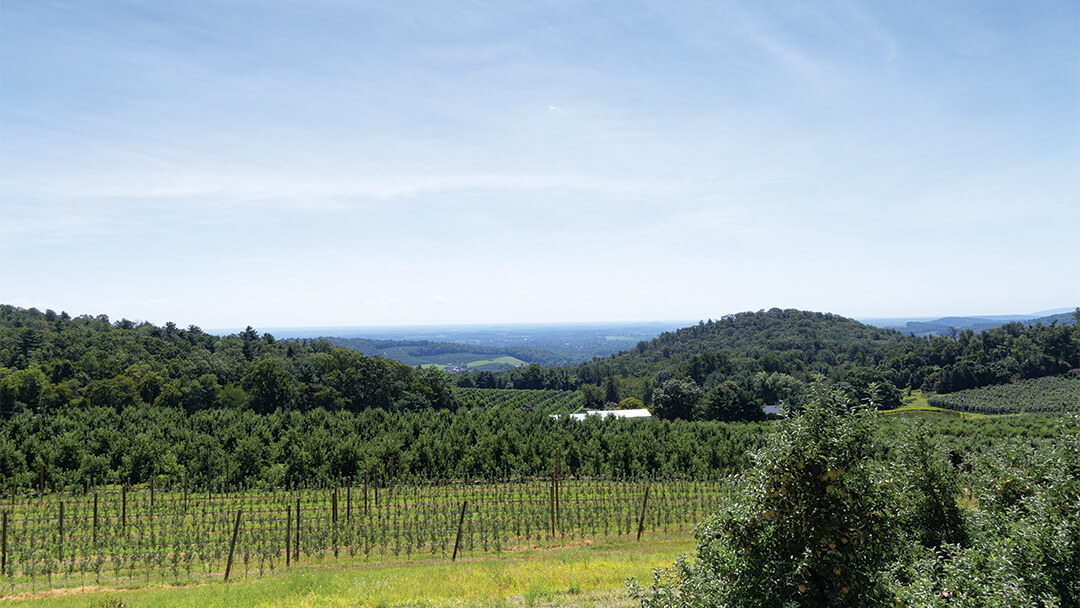
A view from Mt. Ridge Farms in Adams County, Pa.
“There’s always the potential that you can have a genetic mutation,” says Robert Crassweller, Penn State professor of horticulture and fruit tree production specialist. “Or that a bud may be a little bit different, just like each son or daughter is not exactly the same as their brother or sister. They happened to notice that this particular tree would mature earlier.”
That’s how the older varieties like Red Delicious and McIntosh, which were discovered in the 1800s, came about: chance seedlings. But breeding programs at universities across the country work to develop new varieties, and these days even private organizations are getting into the game. They’re all trying to find something that will hit the market as hard as Honeycrisp did.
“A lot of people had the same idea at the same time,” says Rice, “which was if (Honeycrisp) was released out to everybody and everybody has an ability to get into the supply and we’re still making all this money, what would happen if I had something that was as good, as desirable as a Honeycrisp but I was the only one who can have it? Let’s do that. And about 50 people had the same idea and they all started at the same time.”
These managed or club varieties are thus named because growers pay fees and royalties to be able to plant the trees.
“They put exclusive rights on those varieties,” says Crassweller. “And they only allow certain people to grow them and a certain number of trees to be grown. It’s to keep the supply down so the demand is high.”
That demand passes up the supply chain. Factor in the new growing practices in which tree density increases nearly tenfold, and you’re looking at a tree shortage.
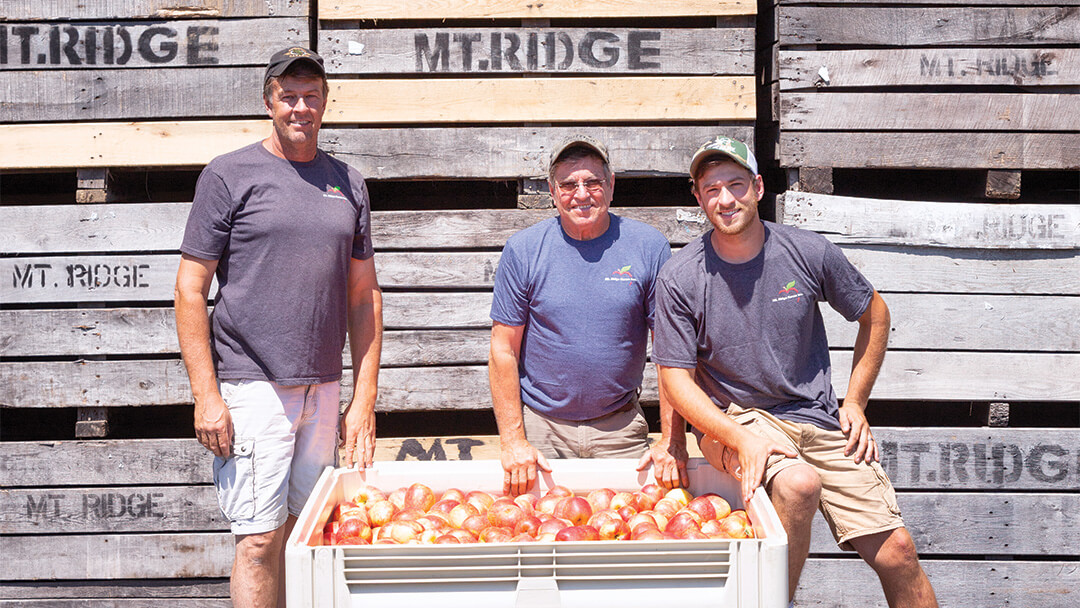
Three generations of apple growers at Mt. Ridge Farms: Dave, Steve and Blake Slaybaugh
“It’s almost a three year process from the time you decide you want to plant a Honeycrisp on a certain root stock before you get the tree to plant,” says Brenda Briggs, vice president of sales and marketing at Rice, “and then it takes three years before it comes into production. So you have 6 to 8 years before you can get the apples.”
Between R&L Orchards and the 30-plus growers Rice packs fruit for, Showalter says there are a couple dozen new varieties being tested on the land he’s driving us through.
“It’s not instant gratification when it comes to new varieties,” he says. “You look at pictures of things that are grown somewhere else and you think, ‘Oh, that looks pretty promising,’ and you try to get a fix on the flavor profile, but you want to grow it in your own area to determine what you’re going to have as an end product.”
With hundreds of new varieties hitting the market, growers are pressed to find that next big thing.
“People think gambling is a sin but if farmers aren’t one of the biggest gamblers out there,” laughs Slaybaugh, whose family is also growing the club variety Koru from New York Apple Sales. “You don’t know if an apple is going to take to the land or if the customer is going to like it. You need a strong market to support that. It’s quite taxing. You invest a lot just to hope it takes off.”
Of course, all of this would be incomprehensible to the ancestors of these growers who settled in Adams County for its verdant farmland and soon discovered that the landscape was well suited for apple production.
“Because of the natural lay of our land, we get a naturally good air drainage,” says Showalter. It’s something the namesake of the company he works for recognized hundreds of years ago.
“… It’s to keep the supply down so the demand is high.”
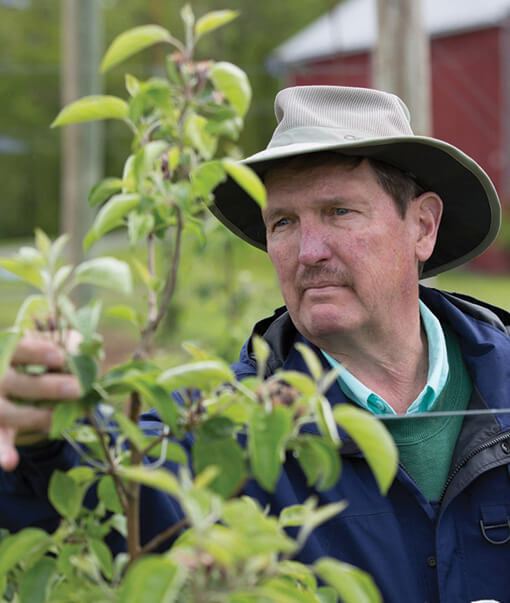
Robert Crassweller | photo by Mike Houtz
“Daniel Rice was a German immigrant,” says Rice of his ancestor. “He grew a number of different produce crops but over time he and his descendants settled very much on apples. That has been eight generations of apple growing in Adams County. It is rather remarkable for a family to be in any business for that many generations but particularly in agriculture where there are so many setbacks.”
Those first settlers, foreigners themselves, would not have forecasted the need for foreign labor brought over on H-2A visas. They couldn’t have imagined the robots being installed at the Rice packing facility to load pallets. They could never fathom the engineering that goes into the sorting lines, which take dozens of photographs of each apple within seconds or the technology behind the near infrared spectroscopy imaging unit that analyzes the fruit underneath the skin.
But Danijel Lolic, engineering manager at Rice who comes from an aerospace engineering background, sees the human element in the science. “We have so many passionate people working within our organization, including our growers,” he says. “You have to be passionate to do this. It’s really rewarding that at the end of the day when you walk out of here, what you did helped contribute to the success of a family farm.”
Despite all the setbacks, all the traditional issues for farmers like not enough rain or too much rain, despite all the changes in the industry like labor shortages and new technology, one thing has remained the same since the first settlers stopped in Adams County and started growing fruit trees.
“To walk into a big storage room and see all those apple bins and know that each apple in there was picked by a human hand,” says Showalter, “it’s still amazing to me after all these years.”
What’s Next?
In the arms race for the next big apple, Ben Rice says the real winners are eaters. “The overall net effect is a rising level of quality experienced by the general consumer,” he says. “You have more and more potential blockbuster choices. The shelf space for a mealy anything is gone.” Here are some new varieties coming soon to a grocery store — or fruit stand — near you.
Developed at Washington State University, Cosmic Crisp (pictured)has parentage of Honeycrisp and Enterprise. The fruit has the desired taste and texture of Honeycrisp but an increased storage capability like the Enterprise.
“Kiku is a special strain of a Fuji apple that has an even higher level of sugar,” says Briggs. “It’s a really nice apple. It was one of the earlier branded varieties to hit the market, about 10 years ago.” Rice is one of three companies in the U.S. that sells Kiku apples.
Developed in New Zealand, Koru is a chance seedling from a cross between Fuji and Braeburn.
New from Lancaster-based Hess Bros. Fruit Co., Sweet Cheeks comes from Honeycrisp and Cripps Pink, the untrademarked name for the Pink Lady brand.
SweeTango comes from the University of Minnesota, where researchers crossed Honeycrisp and Zestar. The cooperative of growers that have license to grow SweeTango is called Next Big Thing.
EverCrisp was developed by the Midwest Apple Improvement Association (MAIA) and is a cross between Honeycrisp and Fuji. Originally developed in Ohio, EverCrisp entered the market in 2017.
Also new from MAIA, Ludacrisp will look to capitalize on both Honeycrisp fame and a name with the potential to go viral.
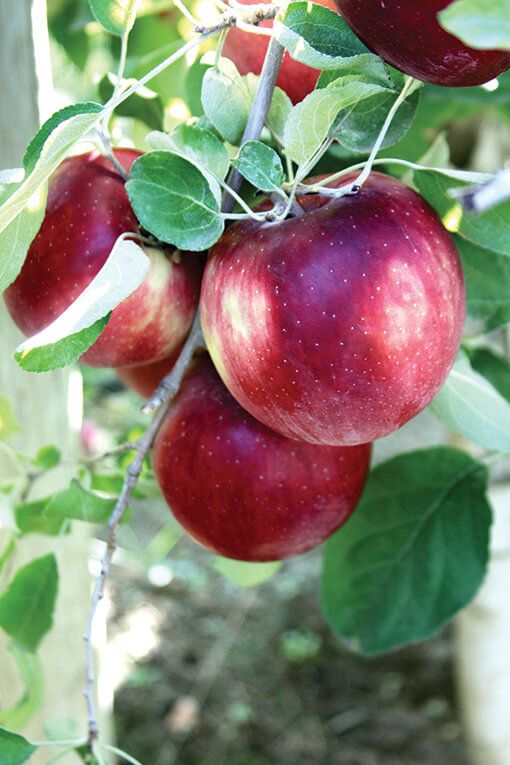
WA 38 will be marketed as Cosmic Crisp
More from Provisions magazine
Letter from the Editor
t’s hard to know how to start a letter right now — nothing seems big or small enough. Our world has both drastically shrunk to our own homes and reached a new level of global connectivity. Anxiety and stress have spiked (and stayed there), but...
Cooking the Commonwealth
hat’s the most quintessential Pennsylvania food? If you answered soft pretzels, or scrapple, or cheese steak, you’re certainly not wrong. But Carrie Havranek, author of Tasting Pennsylvania, insists that there’s much more on the table across the...
Nowruz 1399: The Ghosts of New Years Past and Future
When I proposed writing a piece on the Persian New Year, which coincides with the spring equinox and which we celebrate every year in homage to my husband’s Iranian ancestry, I was excited. We have been renovating our house — the work is still ongoing and many things...

